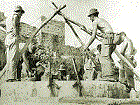The Dianas

The Dianas were a series of defensive positions along the southern edge of the Jebel Massive in Oman between 1973 and 1975. Five Dianas were formed and designed to keep the rebels from bringing long-range weapons to the lip of the Jebel from where they could observe and fire down on the RAF base and nearby town of Salaha. The Dianas came under constant attack and were heavily defended by mainly SAS personnel. During the Dhofar campaign of 1970-76, the Sultanate of Oman erected a series of five defensive lines or barriers to provide protection for the areas under government control as they expanded. They comprised barbed wire fences and minefields with defended bases from which units of the SAF would operate. The lines were: Simba Line: Manned by a regular battalion of the SAF, with a Firqat unit located at Sarfait, on the border with Yemen.
Denavend Line: Completed in April 1975 and was manned by Iranian Special Forces who arrived in early 1973.
Hornbeam Line: From Mugsayl on the coast 64 km inland to Oven, with a defensive position sited every 1,800 metres, on high ground linked by barbed wire fences and minefields.
Hammer Line: Established on the Jebel Khaftawt as a long stop in support of the Hornbeam line, occupying similar positions as the Leopard line.
Leopard Line: From Jebel Khaftawt down to Windy Ridge with three defensive positions but was withdrawn in mid-1972 because of supply problems during the monsoon season.

The Royal Engineers played a crucial part in the campaign. Operation Tenable brought in RE assistance to build defenses and mine fields. Hornbeam Line was perhaps their greatest feat consisting of 53 KM of wire fence and mine fields. For eight months each year, there was a Royal Engineer Squadron based in the Dhofar. A Major Blashford-Snell commanded one of these RE squadrons. Colonel Blashford-Snell later became well known for leading the Blue Nile Expedition.



